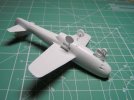f2k
New Member
- Joined
- Apr 2, 2011
- Messages
- 301
It's been nearly a month since I moved and I'm almost settled in so I suppose I better get building.

This then, is a Lavochkin La-174TK. And no, I don't know what that is either...
From what little information I have been able to find, this is an experimental variation of the Lavochkin 156 which was itself a prototype version of the Lavochkin 152, equipped with a more powerful engine than the standard 152.
Good enough to qualify for the prototype catagory, I trust... ;D
What was special about the 174TK was its wings. Straight and very thin, it's believed (acording to Wikipedia, anyway) that it was the thinnest wings yet flown at that time.
Taking to the air in early 1948, it reached at top speed of almost 1000 km/h at sea level and could climb to an altitude of 5000 meters in only two and a half minute.
Sounds impressive, but the swept-wing La-160 had been flying for nine months by then and was showing even better results so the program was canceled.
Eventually, the Yak-23 was chosen for production and this series of aircraft seems to have slipped into obscurity.
How did I end up with the model in my collection then?
Well, pretty simple really. One day I was trawling eBay for deals and this showed up in the "You might like..." section. I thought it looked interesting so I bought it without actually knowing much about it.
The kit itself is exceedingly simply with just 39 parts, a decal sheet, and a single sheet of paper with very basic instructions and a single paint-scheme.

Not much else to say about it right now. According to the only build-log I can find with this particular model it's a bit of a trial to put together. But I'll find out myself, I suppose.
I'm planing to rig up my airbrush tomorrow and then I'll get working on the cockpit. It's build as a tub that's inserted into the aircraft so I'll need to get it painted before gluing it together.
Truth to be told, I'm just going to wing this one. Aha ha ha ha...
Sorry, pad pun...
But honestly, I don't yet know quite where I'm going with this. The build itself looks pretty straight forward and the paint-scheme (grey, grey, and yet more grey) isn't exactly inspiring.
If only the kit had included a pilot I might have been able to do something interesting. But sadly it seems that pilots are in short supply in most kits. And modeling it in an "at easy" pose on the ground doesn't quite work either as the canopy is a one-piece affair with very shallow details that does not allow modelling the plane with open cockpit.

This then, is a Lavochkin La-174TK. And no, I don't know what that is either...
From what little information I have been able to find, this is an experimental variation of the Lavochkin 156 which was itself a prototype version of the Lavochkin 152, equipped with a more powerful engine than the standard 152.
Good enough to qualify for the prototype catagory, I trust... ;D
What was special about the 174TK was its wings. Straight and very thin, it's believed (acording to Wikipedia, anyway) that it was the thinnest wings yet flown at that time.
Taking to the air in early 1948, it reached at top speed of almost 1000 km/h at sea level and could climb to an altitude of 5000 meters in only two and a half minute.
Sounds impressive, but the swept-wing La-160 had been flying for nine months by then and was showing even better results so the program was canceled.
Eventually, the Yak-23 was chosen for production and this series of aircraft seems to have slipped into obscurity.
How did I end up with the model in my collection then?
Well, pretty simple really. One day I was trawling eBay for deals and this showed up in the "You might like..." section. I thought it looked interesting so I bought it without actually knowing much about it.
The kit itself is exceedingly simply with just 39 parts, a decal sheet, and a single sheet of paper with very basic instructions and a single paint-scheme.

Not much else to say about it right now. According to the only build-log I can find with this particular model it's a bit of a trial to put together. But I'll find out myself, I suppose.
I'm planing to rig up my airbrush tomorrow and then I'll get working on the cockpit. It's build as a tub that's inserted into the aircraft so I'll need to get it painted before gluing it together.
Truth to be told, I'm just going to wing this one. Aha ha ha ha...
Sorry, pad pun...
But honestly, I don't yet know quite where I'm going with this. The build itself looks pretty straight forward and the paint-scheme (grey, grey, and yet more grey) isn't exactly inspiring.
If only the kit had included a pilot I might have been able to do something interesting. But sadly it seems that pilots are in short supply in most kits. And modeling it in an "at easy" pose on the ground doesn't quite work either as the canopy is a one-piece affair with very shallow details that does not allow modelling the plane with open cockpit.




